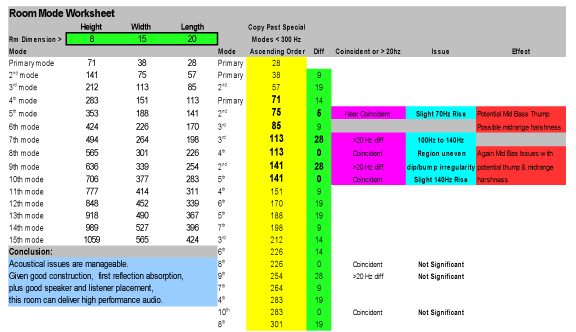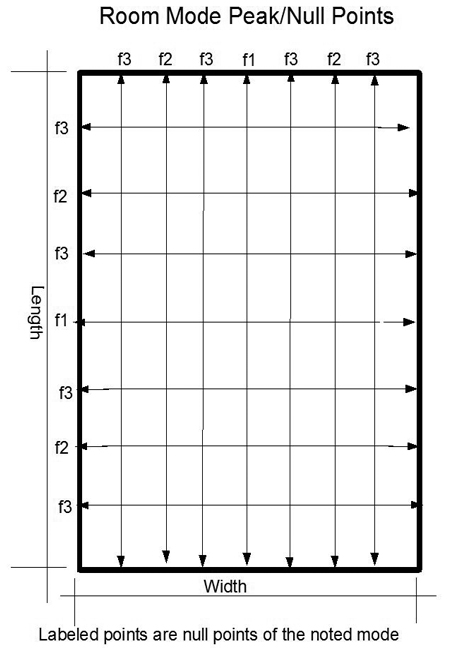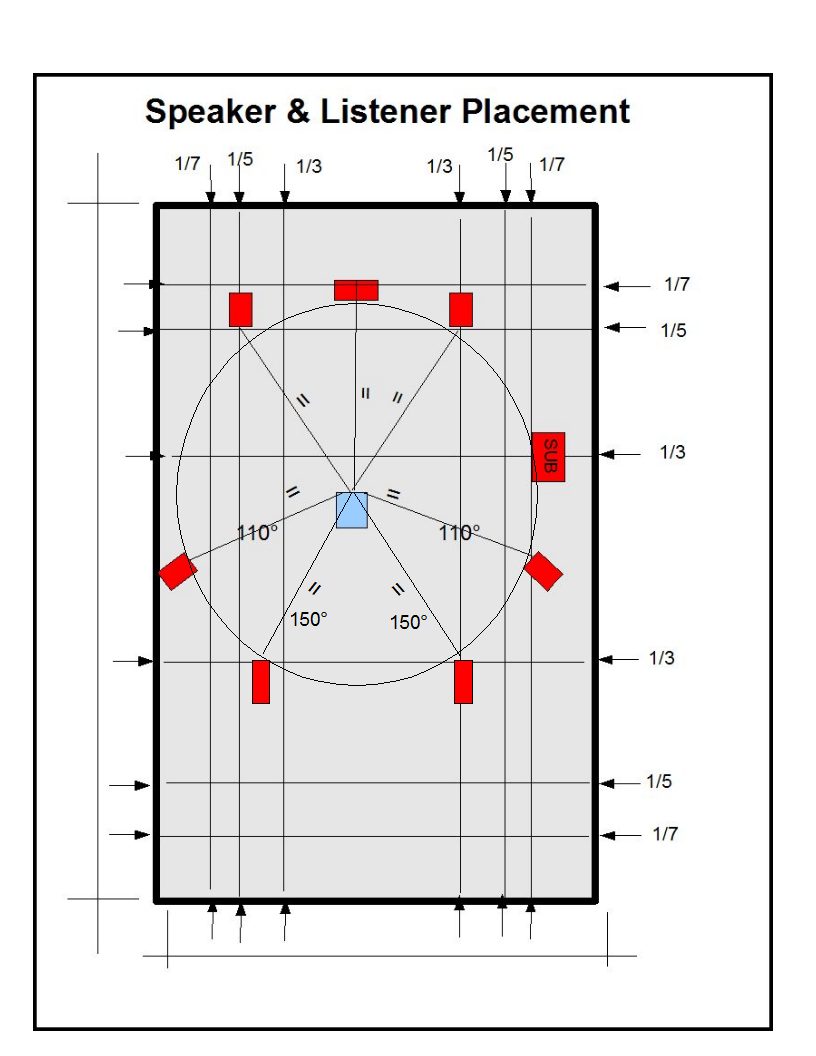Ed's
AV Handbook
Batting practice for the AV Professional
and primer for the novice
Chapter 7 Page 3
An Acoustical Strategy
for the small room
Acoustical tactics for the 2nd region
You cannot eliminate room
modes. But room modes are manageable. Begin the
management process by designing or selecting a room with
dimensions that produce a more even distribution of room
modes. The following ratios from the 'Master Handbook of
Acoustics' will assist.
1 : 1.14 : 1.39 1 : 1.26 : 1.59
1 : 1.28 : 1.54 1 : 1.30 : 1.9
1 : 1.14 : 1.39 1 : 1.26 : 1.59
1 : 1.28 : 1.54 1 : 1.30 : 1.9
1 :
1.40 : 1.9
1 :
1.50 : 2.5
1 : 1.60 : 2.3 1 : 1.60 : 2.6*
1 : 1.60 : 2.3 1 : 1.60 : 2.6*
*Golden
Ratio / George Cardas
Do not panic if you cannot
accommodate these ratios. The ratios are guidelines
that minimize the issue. Potential distorting modes
still exist with any ratio.
If you are of the curious nature -- draft a mode analysis of the proposed room to expose any potential room mode issues. Locate modes below 300Hz. Analyze their spacing. Identify coincidences and isolated modes spaced more than 20Hz. For the less curious skip to the next paragraph.
If you are of the curious nature -- draft a mode analysis of the proposed room to expose any potential room mode issues. Locate modes below 300Hz. Analyze their spacing. Identify coincidences and isolated modes spaced more than 20Hz. For the less curious skip to the next paragraph.

F1/F3 Floor Plan Sketch
Create a sketch of the room mode peak and null points of F1 through F3 on the proposed floor plan.The points equal the length and width divided by an even number.
Use this floor plan sketch to manage/select speaker and listener placement.

Mounkes Speaker Listener Placement
If I had to pick one practical audio application from the Handbook -- this is it.My late friend Steve Mounkes taught me this simple speaker/listener placement method many moons ago.
This method, plus a dose of room treatment, delivers substantial audio improvement.
1. Divide the room width by values 3, 5, 7, & 9.
Measure, and mark the results along the width of the room from the left corner, then the right corner.
2. Next, divide the room length by the same values.
Mark these points along the room length from the front left and right corners.

Stereo coordinates
Observe the on-floor coordinates established by the width and length points.While avoiding the peak and null coordinates on the F1/F3 sketch, select a pair of practical coordinates for the stereo left and right speakers.
Then place the listening position in an equilateral triangle with the two speakers.
Surround sound locations
A multi-channel surround sound system is a circular configuration that introduces additional speakers onto the stereo arrangement.Its radius is the distance from the listening positions to the front stereo left/right speaker locations.
Center channel speaker
Place the center speaker on the radius mid-point between the front left and right speaker positions.Rear speaker placement
5.1 -- Place the rear speakers of a 5.1 surround sound arrangement at 110° left and right of the front center speaker.6.1 -- Place another rear speaker at 180° of the front center speaker.
7.1 -- Place two rear speakers; one 150° left, and the second 150°right, of the front center speaker.
Additional seating
The listening position of the equilateral triangle is the ideal seating location. However, additional seating is probably desirable.Therefore, select additional-comfortable-positions that avoid room mode peak and null points.
Subwoofer placement
Finally, while evading peak and null points, select the placement of the subwoofer.If the subwoofer is placed sufficiently away from the room boundary but less than 1/4 of the dimension, it will minimize stimulating modes F1 through F4.
Please refer to Chapter Six, page 5, for detailed instruction.
Final Tuning
If troublesome distorting room modes persist, absorb them with the placement of a broad bandwidth bass trap in the corner nearest each speaker.In the final analysis, subjectively fine-tune all speaker and listener positions with the organic sound meter that is attached to your head.
It is still the most sensitive listening device available.
Additional note for the 2nd Region:
Consider experimenting with multiple subwoofers placed in null locations.Multiple subwoofers may create a more even distribution of the low-frequency sound.
Ed's AV Handbook
Copyright 2007 Txu1-598-288 Revised 2024
Sponsored By

Architectural Speaker Tuning System
for
in-wall/ceiling custom installed speakers.
Reclaim
The Performance You Paid For
Site Menu
Home
Table of
Contents
Handbook Chapters
1 AV
Terms
2 AV Physics
3 Sound Reproduction
4 Video Reproduction
5 The AV System Sequence
6 The Room, Speaker, & TV
7 Acoustical Strategy - Small Room
8 Home Theater by Design
9 AV Sales Training
10 AV Business & Marketing
Contact
About